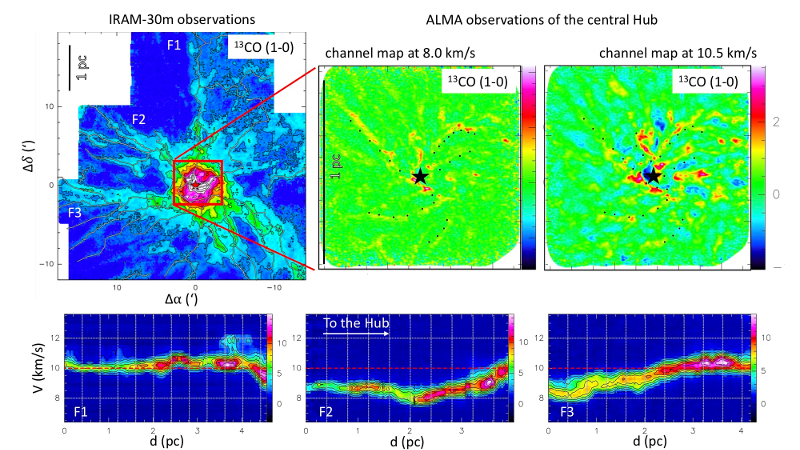| EPoS Contribution |
|
Are Spiral Filamentary Structures Ubiquitous in Massive Star-Forming Regions?
Sandra Trevino-Morales OSO/Chalmers, Goeteborg, SE | |
| In the last years, Herschel revealed that molecular clouds are formed by networks of filaments converging in high-density regions called hubs. The advent of ALMA allows now the study of these filament-hub systems with unprecedented resolution and sensitivity. The MonR2 massive star-forming region, located at only 830 pc, is the most active star formation site in the Monoceros molecular cloud. It harbors a recently formed high-mass stellar cluster associated with a young HII region, and surrounded by a series of photon-dominated regions. Herschel maps revealed a filamentary network converging into the central hub that hosts the HII region. In order to study the dynamics and chemistry of MonR2, we obtained large-scale maps of different molecular tracers with the IRAM-30m telescope. We identify a number of velocity-coherent filaments with velocity gradients of 1-2 km/s/pc, corresponding to mass accretion rates of a few 10-4 Msun/yr. The filaments have signs of fragmentation indicating that stars can form along the filaments before all the mass is gathered in the central hub. The filamentary structure is also present within the hub, where we find hints of a spiral structure approaching the HII region. Recently obtained ALMA images, confirm the presence of spiraling filaments converging towards the central region where the most massive stars form. Similar structures have been found, although with lower spatial resolution, in other massive star-forming regions, posing the question whether these structures are required in the formation of massive stars or are an outcome of the accretion process. | |
 | |
| Caption: Left-top: MonR2 filamentary structure as seen by 13CO(1-0) transition line (IRAM-30m observations). The withe/black countours represent the skeletons of the identified filaments and the red star indicates the position of the HII region. The labels F1, F2, and F3 indicate the position of three of the most prominent filaments in the region. Right-top: Close-up view of the central hub as seen by ALMA, channel maps of the 13CO(1-0) transition line at 8 km/s (center) and 10.5 km/s (right). The black dots indicate the position of the main spiral arms and the black star correspons to the HII region position. Bottom: Position-velocity diagrams of the filaments F1, F2, and F3. The red-dotted horizontal line indicates the system velocity (10 km/s) | |
| Collaborators: A. Fuente A Sanchez-Monge J. Kainulainen P. Didelon F. Motte P. Pilleri T. Rayner N. Schneider P. Tremblin |
Key publication
Suggested Session: Cores |

